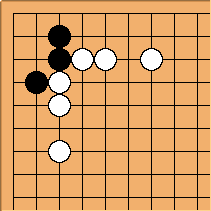There are several essential life and death patterns that quite commonly occur in games, however can be quite tricky to master. I think knowledge and familiarity with many of them are vital (necessary but not sufficient) for becoming stronger (reaching shodan and beyond).
If you’ve never heard of patterns like L groups, L+1, L+2, J groups, J+1, tripod, notcher, long L, door group, hovercraft, carpenter’s square, etc, and you are a DDK working toward SDK, or even an SDK working toward dan, then I think the below linked resources are valuable.
You could also figure out a lot of these patterns on your own by solving enough tsumego, but I think at least for some, systematic study could be beneficial. There are definitely many other great resources, but here are a few that I know about and found to be helpful.
1. Sensei’s Library
Sensei’s Library has a great catalog of common life and death shapes:
In particular, see the “Corner Shapes” and “Side Shapes” sections.
2. “Life and Death” book by James Davies
James Davies wrote a nice book called simply “Life and Death”. Each chapter focuses on a pattern or concept, spends a couple of pages discussing it, and then provides about six problems to further explain and explore variations.
3. Video by Haylee (Lee Hajin)
Here is a list with Sensei’s Library links for the corner shapes covered in this video:
- L-group
- L+1 group (first type, wider)
- L+1 group (second type, longer)
- L+2 group with a weak leg
- Hovercraft with descent (scroll down on this page)
- Unknown name?
- Unknown name? Discussed here: Puzzle from a recent game. Black to kill
- Long L group with descent
- Unknown name? Looks like an incomplete long L
- Unknown name?
4. Participate in the study group formed in this thread
How about every now and then we post in this thread one of the common patterns, linking the Sensei’s library page and some problems to consider, and then we (for anyone that’s interested in participating) read the materials and work through understanding the pattern and problems together?
I’ll start this with my next post in this thread (either later today or tomorrow, to give me some time to gather materials), with the first topic being the “L group”.





































